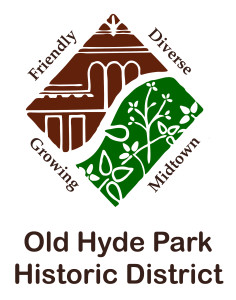By: Bob Beachy When I drew the assignment to write a piece in our Kansas City Neighborhood Series on Hyde Park, I went into the process without much detailed knowledge of an area which I have driven through for many years. Shortly, it became apparent that this area is extremely rich in history. More importantly, I realized that a lot of that rich history had a direct bearing on my family. My grandfather, Robert S. Beachy, married and moved into Kansas City around 1910. He and my grandmother purchased a house in Hyde Park on the 3200 block of Harrison where my father was raised through his teenage years.  The Hyde Park area is defined as the largely residential community between 31st Street and 42nd Street on the north and south boundaries and Troost and Gillham on the east and west boundaries. Within that area are many notable Kansas City establishments, like churches, schools and dwellings. According to Dona Boley and Kenneth Alley, who wrote “Kansas City’s Historic Hyde Park”, the area was part of the City Beautiful Movement and the actual design in 1887 of Hyde Park was one by the famous city architect George Kessler. Mr. Kessler designed Gillham Road and Gillham Park as part of the wide avenue concept so characteristic of the City Beautiful Movement. In the 1890s, the homes in the area became some of the more fashionable dwellings in Kansas City. Residents established a park area which contained tennis courts, croquet grounds and archery ranges. A golf course was developed and the residents later leased pasture land in what is now Loose Park for a new and better golf course, which later evolved into the Kansas City Country Club. In 1897, a development was established in Hyde Park known as Janssen Place. It was a rectangular, gated community and the gothic columns, which comprise the entrance to the parallel boulevards and phenomenal houses within, were designed by George A. Mathews at the direction of railroad magnate Arthur Stilwell (founder of Kansas City Southern Railroad and a Hyde Park resident) in 1897. The mansions were originally built for some of Kansas City’s founding families, many of whom were lumber barons or heirs to substantial retail fortunes. Many of those mansions remain today in Janssen Place and are a testament to some of the greatest residential construction in Kansas City’s history. There were a number of other terrific homes built in Hyde Park, particularly along Armour Boulevard. Unfortunately, many single family homes were converted to apartments from the 1940s through the 1960s. Most of those homes were originally built between 1890 and the late 1930s and many have been lovingly restored to their single family status by a new enthusiastic wave of Hyde Park residents who are interested in returning the community to its former grandeur. The area boasts landmark buildings, such as the Bellerive Apartments on Armour Boulevard (built in 1922), Westport High School (1908), Central Presbyterian Church (1921) and Stine McClure Funeral Home (1912). It was extremely interesting to me that my father attended Hyde Park Grade School, Westport High School and Central Presbyterian Church. He made a deal with my grandfather to attend the Junior College of Kansas City, across the street from the high school, and work for a year in exchange for a car when he later went to Missouri University. Fittingly, Memorial Services for my grandfather were held at Stine McClure. The area has considerable history dating back to when the Santa Fe Trail actually ran through the neighborhood in the 1800s, going down what is now Harrison and through Janssen Place. It has boasted many notable families and individuals as residents. In the past, Meiner’s Grocery Store was located in the 4100 block of Holmes and various drug stores and soda fountains abounded. The Lillis family occupied the prominent residence at 301 E. Armour Boulevard and churches and schools, such as Notre Dame de Sion Grade School, St. James Catholic Church, St. Mark’s Lutheran Church and the Pilgrim Chapel, Central Presbyterian Church and Trinity United Methodist Church on Armour Boulevard, and the recent Eagle Scout Memorial on Gillham Road are all landmark venues. The area has been home at various times to at least four Mayors of Kansas City, including the present Mayor, Sylvester James. Gillham Park itself and its environs remain a rich, historic jewel located in the midst of Kansas City. I can’t help but reflect on what a terrific place this must have been for my father to spend his youthful days and how vibrant the neighborhood remains a century later. The Hyde Park Neighborhood Association is still extremely active and the numerous residential restorations that are ongoing to bring this important part of Kansas City back to its prior majesty.
The Hyde Park area is defined as the largely residential community between 31st Street and 42nd Street on the north and south boundaries and Troost and Gillham on the east and west boundaries. Within that area are many notable Kansas City establishments, like churches, schools and dwellings. According to Dona Boley and Kenneth Alley, who wrote “Kansas City’s Historic Hyde Park”, the area was part of the City Beautiful Movement and the actual design in 1887 of Hyde Park was one by the famous city architect George Kessler. Mr. Kessler designed Gillham Road and Gillham Park as part of the wide avenue concept so characteristic of the City Beautiful Movement. In the 1890s, the homes in the area became some of the more fashionable dwellings in Kansas City. Residents established a park area which contained tennis courts, croquet grounds and archery ranges. A golf course was developed and the residents later leased pasture land in what is now Loose Park for a new and better golf course, which later evolved into the Kansas City Country Club. In 1897, a development was established in Hyde Park known as Janssen Place. It was a rectangular, gated community and the gothic columns, which comprise the entrance to the parallel boulevards and phenomenal houses within, were designed by George A. Mathews at the direction of railroad magnate Arthur Stilwell (founder of Kansas City Southern Railroad and a Hyde Park resident) in 1897. The mansions were originally built for some of Kansas City’s founding families, many of whom were lumber barons or heirs to substantial retail fortunes. Many of those mansions remain today in Janssen Place and are a testament to some of the greatest residential construction in Kansas City’s history. There were a number of other terrific homes built in Hyde Park, particularly along Armour Boulevard. Unfortunately, many single family homes were converted to apartments from the 1940s through the 1960s. Most of those homes were originally built between 1890 and the late 1930s and many have been lovingly restored to their single family status by a new enthusiastic wave of Hyde Park residents who are interested in returning the community to its former grandeur. The area boasts landmark buildings, such as the Bellerive Apartments on Armour Boulevard (built in 1922), Westport High School (1908), Central Presbyterian Church (1921) and Stine McClure Funeral Home (1912). It was extremely interesting to me that my father attended Hyde Park Grade School, Westport High School and Central Presbyterian Church. He made a deal with my grandfather to attend the Junior College of Kansas City, across the street from the high school, and work for a year in exchange for a car when he later went to Missouri University. Fittingly, Memorial Services for my grandfather were held at Stine McClure. The area has considerable history dating back to when the Santa Fe Trail actually ran through the neighborhood in the 1800s, going down what is now Harrison and through Janssen Place. It has boasted many notable families and individuals as residents. In the past, Meiner’s Grocery Store was located in the 4100 block of Holmes and various drug stores and soda fountains abounded. The Lillis family occupied the prominent residence at 301 E. Armour Boulevard and churches and schools, such as Notre Dame de Sion Grade School, St. James Catholic Church, St. Mark’s Lutheran Church and the Pilgrim Chapel, Central Presbyterian Church and Trinity United Methodist Church on Armour Boulevard, and the recent Eagle Scout Memorial on Gillham Road are all landmark venues. The area has been home at various times to at least four Mayors of Kansas City, including the present Mayor, Sylvester James. Gillham Park itself and its environs remain a rich, historic jewel located in the midst of Kansas City. I can’t help but reflect on what a terrific place this must have been for my father to spend his youthful days and how vibrant the neighborhood remains a century later. The Hyde Park Neighborhood Association is still extremely active and the numerous residential restorations that are ongoing to bring this important part of Kansas City back to its prior majesty.
Footer
© Van Osdol, PC. All rights reserved.
The choice of a lawyer is an important decision and should not be based solely upon advertisements.

